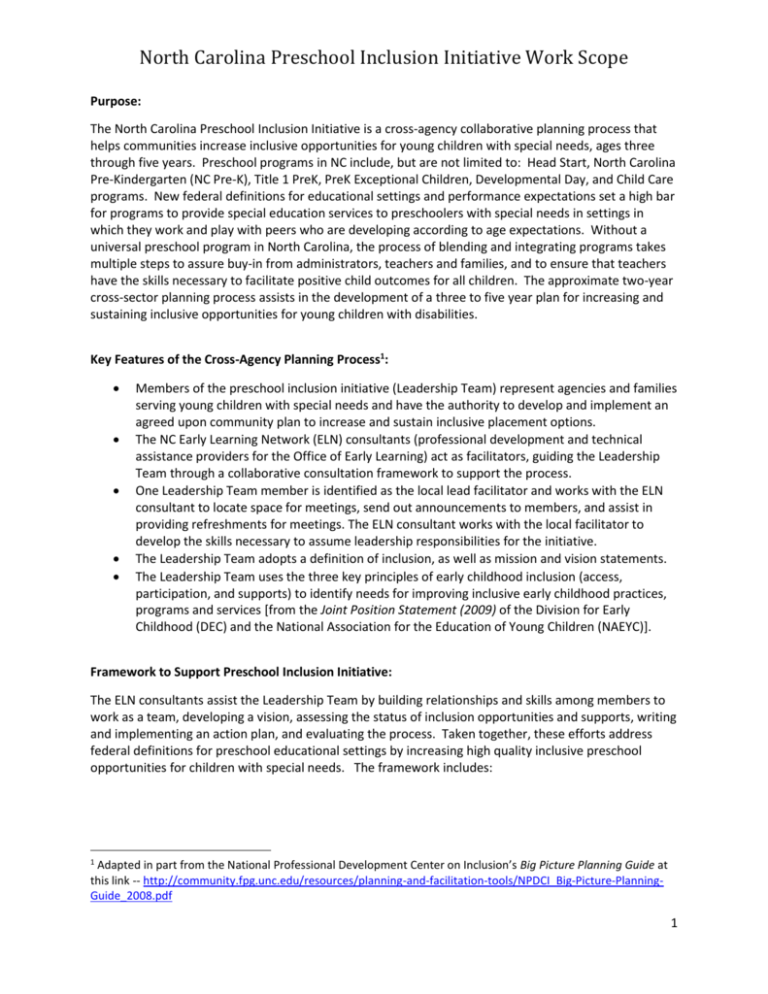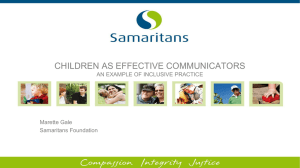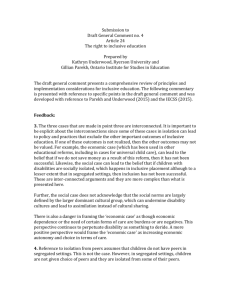North Carolina Preschool Inclusion Initiative Work Scope
advertisement

North Carolina Preschool Inclusion Initiative Work Scope Purpose: The North Carolina Preschool Inclusion Initiative is a cross-agency collaborative planning process that helps communities increase inclusive opportunities for young children with special needs, ages three through five years. Preschool programs in NC include, but are not limited to: Head Start, North Carolina Pre-Kindergarten (NC Pre-K), Title 1 PreK, PreK Exceptional Children, Developmental Day, and Child Care programs. New federal definitions for educational settings and performance expectations set a high bar for programs to provide special education services to preschoolers with special needs in settings in which they work and play with peers who are developing according to age expectations. Without a universal preschool program in North Carolina, the process of blending and integrating programs takes multiple steps to assure buy-in from administrators, teachers and families, and to ensure that teachers have the skills necessary to facilitate positive child outcomes for all children. The approximate two-year cross-sector planning process assists in the development of a three to five year plan for increasing and sustaining inclusive opportunities for young children with disabilities. Key Features of the Cross-Agency Planning Process1: Members of the preschool inclusion initiative (Leadership Team) represent agencies and families serving young children with special needs and have the authority to develop and implement an agreed upon community plan to increase and sustain inclusive placement options. The NC Early Learning Network (ELN) consultants (professional development and technical assistance providers for the Office of Early Learning) act as facilitators, guiding the Leadership Team through a collaborative consultation framework to support the process. One Leadership Team member is identified as the local lead facilitator and works with the ELN consultant to locate space for meetings, send out announcements to members, and assist in providing refreshments for meetings. The ELN consultant works with the local facilitator to develop the skills necessary to assume leadership responsibilities for the initiative. The Leadership Team adopts a definition of inclusion, as well as mission and vision statements. The Leadership Team uses the three key principles of early childhood inclusion (access, participation, and supports) to identify needs for improving inclusive early childhood practices, programs and services [from the Joint Position Statement (2009) of the Division for Early Childhood (DEC) and the National Association for the Education of Young Children (NAEYC)]. Framework to Support Preschool Inclusion Initiative: The ELN consultants assist the Leadership Team by building relationships and skills among members to work as a team, developing a vision, assessing the status of inclusion opportunities and supports, writing and implementing an action plan, and evaluating the process. Taken together, these efforts address federal definitions for preschool educational settings by increasing high quality inclusive preschool opportunities for children with special needs. The framework includes: 1 Adapted in part from the National Professional Development Center on Inclusion’s Big Picture Planning Guide at this link -- http://community.fpg.unc.edu/resources/planning-and-facilitation-tools/NPDCI_Big-Picture-PlanningGuide_2008.pdf 1 I. Creating the Preschool Inclusion Initiative Group The Leadership Team, representing agencies that serve children with and without disabilities and their families, is created to engage in a cross agency collaborative process known as the Preschool Inclusion Initiative. The group works with ELN consultants to create a structure for decision making, management of planning tasks, and activities. The group, through consensus, adopts a definition of inclusion and develops a shared vision for inclusive opportunities for children with special needs. New members may be added to the Initiative as the group identifies key agencies to help implement the plan. The group must have the support of the Exceptional Children Program Director and should include administrative and classroom representatives from the cross-sector programs willing to participate e.g., NC Pre-K, Developmental Day, Title I PreK, Head Start, Child Care, and family members. II. Taking Stock -- Assessment of Strengths and Needs Each Leadership Team assesses the current status of their county’s inclusive practices and settings by using assessment tools provided by the ELN consultants. Tools and information include: The North Carolina Preschool Self Evaluation – a comprehensive evaluation of Pre-K services, The Preschool Program Inclusion Partnership Preschool Program Profile – tabulating how many classrooms are inclusive & the breakdown of number of children, number of children with IEPs, staffing, Surveys of teacher, administrator, and family perceptions of inclusion, as well as practices to support inclusion, and Strengths, Needs & Resources – identifying the community’s strengths and resources for early childhood inclusion and concerns /needs. III. The Implementation Plan The Office of Special Education Programs (OSEP) in the US Department of Education has funded a technical assistance center to assist in scaling up high quality, evidence based practices: the State Implementation and Scaling- Up of Evidence Based Practices (SISEP). Through this center’s research we have come to understand that it takes much more than a workshop to implement inclusive practices in the classroom. What does it take to effect change? It takes time It takes resources It takes training It takes coaching It takes data It takes administrative leadership It takes families. Based on the assessment information they collect, the Leadership Team writes an implementation plan that describes goals and strategies for working collaboratively with stakeholders to increase the number of quality inclusive opportunities for children with special needs. Items on the Inclusion Initiative implementation plans have included: 2 Interagency/Interdepartmental agreements that: o Define classroom configurations for the number of designated child slots for children with disabilities and children without disabilities, o Establish fiscal parameters for funding, o Develop child specific considerations for IEP teams when considering inclusive placements, and o Develop the system of support for inclusive classroom teachers. Professional development plans that prepare staff (including administrators) to meet the needs of children with special needs and their families in their classrooms through connected training that occurs over time in multiple formats: o Training on embedded intervention for classroom staff and related service providers, o Training on coaching in the inclusive classroom for support staff, o Establishing professional learning communities and conducting team case studies on embedding goals in the classroom routines, and o Training on writing functional IEP goals and how to progress monitor through functional and activity based assessment. Facilitative Leadership Teams of regular and special education coordinators that intentionally work together to address teacher and parent concerns and barriers that evolve throughout the implementation process. Teams need to work together to create common meeting and training calendars, and provide opportunities for classroom teams to work together. Developing a plan for staff buy-in and initial implementation o Identifying the first adopters for inclusive classrooms(teachers are surveyed to see who is open to having children with disabilities in their classrooms) o Identifying and training support staff to coach and mentor inclusive classroom teachers – Establishing coaching agreements – Developing embedded intervention lesson plans o Identifying ways to communicate the success of initial adopters with the larger teaching community to facilitate further buy-in o Developing a yearly plan for expanding the number of inclusive classrooms and number of inclusive opportunities for children Developing a plan for full implementation- inclusion becomes integrated into practitioner, organization and community programs Leadership team develops goals for increasing the number of inclusive classrooms and partnerships with the exceptional children program over the course of a 2 to 4 year period, given the resources for coaching and providing professional development to new classroom staff. 3 III. Creating a Structure for Continuous Improvement -- Evaluation and Sustainability Throughout the 2 to 4 year process, the Leadership Team develops a portfolio of artifacts to demonstrate progress toward achieving the goals of the Initiative. Strategies are created for monitoring and evaluating the implementation of the plan. This information is used to develop the next year’s implementation plan for sustaining and building on accomplishments. Sustaining changes, once they are in place, requires policies, procedures, funding, and personnel to support continued implementation. Personnel need guidance and training, coaching and consultation to continue to implement quality practices. Continued successful implementation of quality practices involves every level of the system, including state and local agencies, schools, classrooms, teachers/service providers, children, families, and the community. 4








